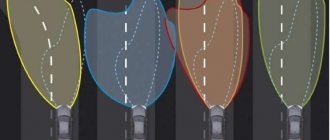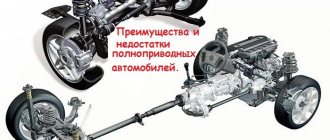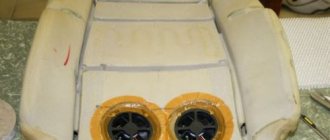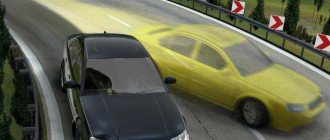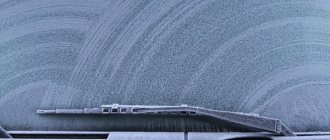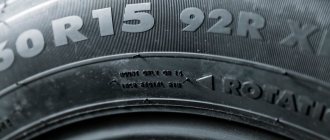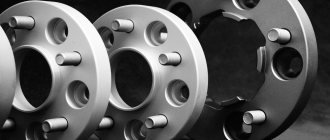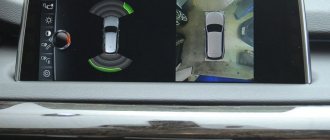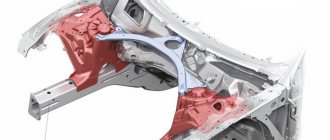When using an Isofix seat, you do not need car seat belts. This is the main feature of the system. For fastening, special locks are used, built into the retractable supports, and iron hinges, which are welded to the car body itself and hidden in the rear seats.
Why install child seats?
The main task is, of course, safety. When you suddenly apply the brakes or crash at a relatively low speed of 60 km/h, it has been proven that a person's weight can increase by more than 30 times.
Helpful information:
- What is vehicle clearance?
- Hot Rod - what is it?
- What is a variator and how it works
- Custom car: what is it?
- Muscle car - what is it?
- What is esp in a car and what is it for?
A secondary, but no less important task is to ensure a comfortable trip for the child. It is comfortable for him to sit, and due to the slight elevation, he can admire the scenery flashing outside the window.
What does it look like
Fasteners for child seats are provided as standard equipment for vehicles manufactured since 2006 and are indicated by the ISOFIX mark or a button in the form of an icon. The rear seats in the car are equipped with fixation elements.
It is important to carefully examine the interior before purchasing a car, since ISOFIX may be hidden and not indicated by special icons. This happens when the upholstery on the chairs has been replaced.
Does my car have isofix?
You have made up your mind and decided to buy a car seat for your child. Now make sure you have this mount. Inspect the back seat, in the space between the cushion and the seat, you should feel the isofix hinges with your hand.
In some cars, the hinges may be located behind plastic plugs. Often the plugs themselves have clues, such as a picture of a baby in a car seat.
Benefits of Isofix
1. It is almost impossible to make a mistake when securing a car seat using Isofix. Special indicators show whether the chair is properly secured. At the same time, according to studies conducted in Europe, up to eight out of ten people make mistakes when securing a car seat with belts. This is a sad statistic - after all, an incorrectly secured car seat will not provide adequate safety for the child.
2. The Isofix mounting system provides better protection for small passengers in the event of an accident. This has been proven by numerous crash tests. The best protection is achieved by rigidly attaching the car seat to the car body.
3. Securing a car seat using the Isofix system is much easier than using car seat belts. Therefore, the installation process is significantly faster and easier compared to fastening with belts.
Components of the Isofix system
The Isofix system consists of two main elements - brackets fixed in the car interior and locks located on the car seat. For additional fastening, an anchor strap (Top Tether) or a leg support is often used.
| The staples are located between the cushion and the back of the seat. Moreover, they can be both in the rear seats and on the front passenger seat. Isofix brackets are rigidly fixed to the car body. The installation locations of the brackets are indicated with special labels. |
| The locks are located on the brackets located at the bottom of the chair. They easily snap onto the brackets, securely fixing the car seat. If you need to remove the seat, then just press one or two buttons (depending on the model of the car seat), and the locks will unlock. To ensure that the brackets do not damage the seat upholstery during installation, plastic extenders are provided. They fit onto Isofix brackets. |
| The anchor belt (Top Tether) is used to secure the top of the car seat (after all, the brackets with locks are located at the bottom of the car seat). This prevents the risk of the seat tilting in the event of an accident. One end of the belt is attached to the top point of the car seat body, the other to a bracket secured in the car. The bracket can be located, for example, on the rear parcel shelf under the glass (in sedans and hatchbacks), on the back of the seat back or on the trunk floor (in station wagons, SUVs and minivans) or in another place in the cabin. The location of the bracket in the car is indicated by a special label. |
| The leg rest is an alternative to the anchor belt and is also designed to prevent the child car seat from tilting in the event of an accident. It rests on the floor and prevents the chair from moving in the event of an accident. |
Application of Isofix
The Isofix fastening system is designed to secure car seats in the passenger compartment intended for transporting children weighing no more than 18 kg. This range includes car seats of groups 0+ and 1.
In group 0+, brackets with Isofix locks are built into a special base on which the cradle of group 0+ is already installed. At the same time, you don’t need to do anything to fix the car seat on the base - just put it on the base. The fasteners will lock automatically.
In group 1, brackets with Isofix locks can be built into the lower part of the car seat (for example - Romer Duo Plus, Maxi-Cosi PrioriFix, Bebe Confort Iseos Isofix), or, as in group 0+, built into the base on which the car seat is installed (for example - Maxi -Cosi Pearl, Recaro Young Expert plus).
However, Isofix fastenings are also used in group 2/3 car seats, designed for transporting children weighing from 15 to 36 kg. But in this case, the Isofix function comes down to additional fixation of the car seat in the car. Which, for example, is convenient when the child is not in the car - the seat will not move around the car interior. At the same time, Isofix fasteners do not perform a restraining function in case of an accident - the child is held in place by standard car seat belts. Although in case of an accident the Isofix fastening system still helps a little. It holds the car seat, thereby reducing the pressure of the belts on the child. After all, the weight of the chair does not put pressure on the child, pressing him even more tightly to the belts.
Almost all car seats with the Isofix system can be secured in the car using a standard seat belt. Therefore, child car seats with Isofix can also be used in cars that are not equipped with Isofix brackets. Please note that Isofix brackets may be included in the car's standard equipment list or offered at extra cost.
Installing a car seat with Isofix
1. Install two plastic extensions onto the Isofix brackets (if necessary) 2. Slide the brackets with locks out of the car seat and install the seat on the car seat. 3. Align the locks with the brackets and push the car seat towards the back of the seat. This will make a click. If the locks correctly grip the staples, the indicator of correct fastening will change color from red to green. 4. Install the anchor strap (if necessary). 5. Adjust the length of the support leg so that the correct adjustment indicator changes its color from red to green. If there is no indicator, make sure that the support leg is firmly in contact with the floor of the car.
| This is what Isofix brackets look like in a car. |
| Labels indicating the location of Isofix brackets |
| This is what the brackets for attaching the anchor strap (Top Tether) look like: |
| Labels indicating the location of the top tether clips |
How to properly install a child car seat
There are 2 brackets in the back of the seat to which the chair clings. The distance between them is regulated by the standard and is equal to 28 cm. There are 2 fasteners on the chair that need to be inserted into the hinges until you hear the characteristic sound of a latch. Everything is quite simple and means the risk of incorrect installation is reduced. The child car seat is securely connected to the body of your car, and the child is fastened to the seat with a five-point seat belt.
What is esp in a car and what is it for?
More about ISOFIX
There are several ways to secure seats in a car.
In European countries, child car seats are attached to the main car seat using the ISOFIX system.
This fastening system was developed in the early 1990s by a European standards organization.
The ISOFIX system, in contrast to attaching a child car seat using a three-point belt, allows you to install a child car seat much faster and greatly facilitates this process.
Every parent strives to seat the child in such a way that he is comfortable and also in such a way that he is safe while the car is moving.
The fact is that children, if they really want it, will be able to move or overturn the relatively light structure in which they were placed, as a result of which they may be in danger.
The ISOFIX system helps solve this problem. Now you don't have to spend a lot of time putting your child in a car seat.
How to properly remove a child car seat
The chair can be easily detached from its hinges; just press a special button to unlock it.
To improve safety, the new seats add a third belt attachment point, on top of the backrest. This increases stability and reduces the risk of the upper back of the child car seat jerking.
You can clearly see the child's dummy's behavior when the brakes are applied suddenly or when there is an accident. The left picture shows the chair without the Top Tether and the mannequin has been thrown much further than in the second picture. In reality, the child would have hit the front seat hard. It is also noticeable in the photo that the back of the child car seat, fastened with a belt from above, practically did not deviate, which means that the seat belts holding the child worked earlier and extinguished the inertia of movement from the first seconds of the accident.
Location of isofix mounts in child car seats
In all age groups of children's car seats, there are various methods of fastening. Some seats are attached only using a car seat belt, and they do not provide isofix fastening; others combine fastening with a belt and isofix; infant carriers of group 0+ can be attached both with a car seat belt and on an appropriate base. There are car seats that can only be attached using an isofix base.
Some manufacturers produce bases for car seats of group 0+, and a car seat of the next age group can be attached to the same base. Group 1 car seats (from 9 months to 4 years) have a built-in isofix mount and mandatory additional elements: floor support or Top Tether anchorage. The exception is some car seats that can only be secured with an isofix mount.
Should I buy a car with an isofix system?
It is enough to list all the advantages of this mount:
- According to researchers, 96% of subjects cope with isofix fastening. While children's car seats are installed correctly using standard seat belts, only 30%.
- Using the isofix system, you will significantly reduce the movement of the car seat with your child to the side or forward and practically eliminate rotation.
- Very quick installation and removal of the car seat.
- You will be sure that the seat is installed securely and your child is safer.
Pros and cons of car seat anchors
The Isofix car seat is a popular restraint system due to its reliability and easy installation.
The system has the following advantages:
- The design is installed simply and quickly. The belts do not have to be threaded through a large number of connectors, as in car seats with traditional anchorages.
- Isofix is easy to attach correctly. Devices with standard mountings are difficult to install. Therefore, more than 70% of such chairs are installed with gross violations.
- Effective protection against injury in road accidents. Numerous crash tests have shown that Isofix provides the safest transport for children.
- Rigid installation of the chair. The device is securely fixed in one place and does not move around the car interior, even if you drive without a child. No need to remove the seat.
- Minimum load on the child's neck.
- The indicator allows you to monitor whether the latch is actuated.
Despite the uniform fastening standard, it is not always suitable for the car model. In addition, Isofix is only suitable for children weighing up to 18 kg. Cradle chairs do not have a built-in Isofix system. You will need to separately purchase a base, the price of which is equal to the cost of the chair itself.
The base is only suitable for one model of car cradle. It is not compatible with other devices, even from the same company, with the exception of rare designs. The brackets must be fastened carefully, because... sharp points may accidentally scratch or tear the upholstery.
How to choose a car seat for a child
First, before choosing a car seat, measure your baby's height and weight. Using these parameters, you can decide on the type of car seat you need.
Zero group.
The group for the smallest includes newborns up to 6 months and up to 10 kg, most often it includes infant carriers. In which the child is transported in a supine position. The cradle is attached to the seat with an isofix system or a standard belt, and the baby is fastened in the cradle itself with a separate belt. It can also be used as a portable crib for a child.
What is an immobilizer
Zero group with plus , it includes children weighing up to 13 kg.
The main difference from the zero group is the ability to install not only on the back seat of your car, but also on the front. A prerequisite is to turn off the airbag, since the child lies with his head towards it and looks into the car interior.
The first group includes children weighing from 9 to 18 kg.
Children's car seats in this group are mainly fastened using regular seat belts, which are found in any car; isofix fastenings are used quite rarely. The child in the seat is fastened with a five-point belt and is positioned facing the direction of the traffic flow.
The second group includes children weighing from 15 to 25 kg.
For children who go to kindergarten, from 3 to 7 years old.
The third group includes children weighing from 22 to 35 kg.
For primary school age from 5 to 12 years.
But not all parents have the opportunity to change child car seats so often, so universal solutions are more popular with us.
These chairs have many adjustments:
- height and width of the back
- tilt angle
- pillow length
- side support height
- headrest height
- seat belt height
They are designed for children from 9 months to 12-13 years.
Isofix fastening system: advantages and disadvantages
Among the advantages of the Isofix system, experts call:
- Easy and quick installation. The car seat can be installed in a matter of minutes. Parents no longer need to thread the standard car seat belts through all the necessary holes.
- Correct installation. According to statistics, up to 70% of all injuries to children in car seats occur due to improper installation. The Isofix child restraint system completely eliminates the incorrect actions of parents.
- Safety of the baby in the event of a collision. Today, experts have not yet come up with a safer fastening method than Isofix. It allows you to combine the car seat with the car body into one whole.
- Mounting rigidity. There is always the possibility of seat belts becoming loose during travel, especially if they are fastened frequently or are used in a hurry. The Isofix safety system is firmly attached to the body, so parents can be absolutely sure that their baby is securely secured.
However, progressive Isofix also has its disadvantages:
- Heavy weight. The presence of the system means that moving the baby in a car seat or infant carrier will be much more difficult.
- High price. A seat with an Isofix mount will cost about half as much as a similar model attached using standard car seat belts.
- Adjusting the car seat. Models mounted with seat belts can be slightly adjusted to suit the child’s needs, for example, to make his position more horizontal. For this purpose, special accessories for car seats are used. Isofix completely eliminates such improvements.
- The need for "adjustment". Not all child travel seats are suitable for absolutely every make of car. The manufacturer most often informs about the compatibility of car seats and car interiors. If there is no such information, parents will have to “try on” the safety devices themselves.
- Limiting the baby's weight. The guarantee of retention of car seat fasteners applies only to models intended for children weighing up to eighteen kg and no more. Otherwise, the system may become detached from the car body during a collision.
The last drawback draws particular attention to the list of car seats that can be used with a safety system.
Disadvantages of isofix mounting
Despite standardization, there are still problems with fastening:
- Automotive companies do not have uniform standards for rear seats and airbag positions. Based on this, the car manufacturer itself sets up compatibility with the isofix system.
- A different number and position of fastening in the car is possible. For example, the Citroen C4 Picasso has isofix on all passenger seats, but more often there are cars with fastenings only on the outer rear seats. Of course, even if there is no special fastening, you can install a child car seat using seat belts and lose all the advantages of the Isofix fastening.
- For older children who are suitable for the second and third groups, one isofix fastening may not be enough, so it is recommended to use standard belts over the child car seat.
How to overcome your fear of driving
Isofix system: what is it and in which cars is it installed?
Isofix is a special safe and reliable way of fixing child car seats to the car body. The name of the system is an abbreviation, translated it means a fastening approved by the international standardization system. Her goal was to introduce a safe way to secure a car seat inside a car, in which the likelihood of error would be minimized. Thus, the answer to interest in what this Isofix system is in a car can be answered: the most successful and safe method of fastening.
The Isofix restraint system attaches the baby carrier quickly, securely and safely. It is divided into two main structural units. The first is special brackets welded to the car body, thus forming one whole with it. The second is a special sled with a snap fastening, located at the bottom of the child car seat. When one part is connected to another, a reliable structure is obtained, and the seat for transporting a child becomes a kind of continuation of the car body. This means that the baby’s safety during a sudden car stop or impact increases significantly.
The Isofix system has been installed in cars for more than a quarter of a century; today, most cars from European and Korean automakers hit the roads with this security system. In Russia, AvtoVAZ also equips all its modern brands with progressive Isofix. However, this does not mean that it is required for installation. Therefore, it is always worth checking with a car dealer about the availability of the Isofix system in each specific car. How to find fastening devices in the cabin? Usually they are installed in the space between the rear seat and the backrest; there are special icons with a schematic image of a child in a car seat, this can be seen in the photo of the Isofix system in the car. The fasteners in the interior can be easily felt; they have special protective caps.
Isofix: what is it?
Children's travel accessories equipped with the Isofix system have won the greatest trust among users. Crash tests that reproduce accident conditions have confirmed the reliability of this innovation. A car seat with an Isofix mount, when deformed in all possible positions, remained as stable as possible according to the electronic sensors.
Isofix in car seats is a system for rigidly attaching a child's seat to stationary car seats. The isofix mount consists of two metal brackets located between the back and seat of the car. With their help, a child car seat or base, which has reciprocal built-in fasteners, is rigidly attached to the car body. This fixation method has become an international standard. The main advantage of this invention is that it reduces the likelihood of incorrect installation of the seat and, therefore, increases the degree of protection of the child. According to statistics, in 70% of cases, parents install a child seat incorrectly, citing inconvenience. If there is an Isofix fastening, it is enough to install the guides and fix the locks on the brackets that are in the car until they click.

